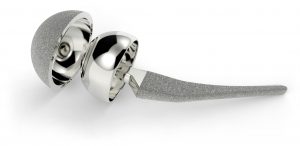November 28, 2017 – San Diego, CA. Hip replacement surgery is not uncommon these days. Nearly 400,000 hip arthroplasty procedures are performed annually in the United States. Total numbers include 2.5 million hip replacement surgeries with people living with a prosthetic by 2010, according to a first-of-its-kind study published by the Mayo Clinic in 2014.
Hip replacement surgery can give a person his or her mobility back when an accident, arthritis or some other ailment makes walking and other daily activities difficult or painful.
Implants used during hip resurfacing are made of metal. Herein lies the problem; implants used during hip resurfacing are always made of metal.
There are a few common types used today:
- Metal on polyethylene – the ball is made of metal and the socket is made of plastic (polyethylene) or has a plastic lining
- Metal on metal – the ball and socket are both made of metal
- Ceramic on metal – the ball is made of ceramic and the socket has a metal lining
These metal-on-metal (MoM) hip implants have come under scrutiny in the past decade after several recalls and an investigation by the Food and Drug Administration (FDA) uncovered some serious complications with the devices. Today, MoM implants are not used as much as they were in the past, but tens of thousands of Americans were implanted with MoM devices before their decline in popularity.
In recent keyword analysis of Google searches we’ve found that many people are concerned with cobalt or chromium poisoning from these hip implants. As these MoM implants age in the user the risk factors increase for cobalt or chromium poisoning. Let’s look at how these hip implants can fail.
Metal-on-Metal can lead to tissue damage, Metallosis
As implants wear down, particles from the implant material are released and can settle in and around the joint. Particles from MoM implants, namely chromium and cobalt ions, can damage surrounding tissues and bone and enter the blood stream. This can lead to complications known as Adverse Local Tissue Reaction (ATLR) and metallosis (metal toxicity).
The tissue damage associated with ATLR can cause necrosis – the death of most or all of the cells in the tissue – as well as the accumulation of lymph cells.
Metallosis is caused by the buildup of metal debris in the soft tissues of the body, even those outside of the joint area. It is estimated that five percent of patients who were implanted with any type of metal joint developed Metallosis over the past 40 years.
Both ATLR and Metallosis can lead to pain, implant loosening and failure, and the need for revision surgery.
What is Cobalt poisoning from hip implants?
Studies performed and gathered by the National Center for Biotechnology Information published a comprehensive article on January 24, 2017 entitled: Neuropsychiatric symptoms following metal-on-metal implant failure with cobalt and chromium toxicity. Its methods involved evaluating ten cases of patients (average age 60) where they looked at neuropsychiatric morbidity following metal-on-metal hip implant failure and revision.
Implants were ASR total hip replacement (acetabular implant, taper sleeve adaptor and unipolar femoral implants) performed between 2005 and 2009. This case series describes, for the first time, neuropsychiatric complications after revision where there has been cobalt and chromium toxicity.
In the study the results presented (directly from the ncbi.nih.gov site) are as follows:
“Pre-revision surgery, nine patients had toxic levels of chromium and cobalt (mean level chromium 338 nmol/l, mean cobalt 669.4 nmol/l). Depression assessment showed 9 of 9 respondents fulfilled the BDI criteria for depression and 3 of these were being treated. 7 of 9 patients showing short term memory deficit with mean mini mental state examination score of 24.2. The normal population mean MMSE for this group would be expected to be 28 with <25 indicating possible dementia.”
Conclusions – “We found neurocognitive and depressive deficits after cobalt and chromium metallosis following MoM implant failure. Larger studies of neurocognitive effects are indicated in this group. There may be implications for public health.
Keywords: Hip implant, Cobalt, Chromium, Depression, Cognitive, Neuropsychiatric, Metal-on-metal”
Signs of hip replacement metallosis symptoms
Some case reports have also shown patients with MoM implants could develop symptoms or illnesses elsewhere in the body, including:
- Skin rashes
- Cardiomyopathy (disease of the heart muscle)
- Hearing or vision impairments
- Psychological changes (depression or cognitive impairment)
- Impaired kidney function
- Thyroid dysfunction (neck discomfort, fatigue, weight gain, feeling cold)
The FDA recommended doctors monitor patients who experienced pain or swelling near the hip, a change in walking ability or noise from hip joint after three months of receiving their MoM implant.
Chromium poisoning symptoms
Chromium is an essential trace nutrient derived from rocks that exists in different chemical states. Chromium exposure can be from inhalation and is listed as an occupational hazard. In acute toxicity symptoms may include:
- Gastrointestinal upset and coma
- Skin and respiratory tract inflammation
- Hepatic impairment
- cardiovascular events
- Haematological effects
- Teratogenicity and carcinogenicity
Cobalt poisoning symptoms
There are over 28 different known isotopes for cobalt including some that are radioactive. Cobalt is also component of cyanocobalamin also known as vitamin B12, which is widely consumed. Studies on both animals and humans have shown that toxicity can happen in all organs of the body with exposure to non-radioactive cobalt. Cobalt poisoning symptoms may include:
- Hearing loss
- Tinnitus (ringing in the ears)
- Headaches
- Polyneuropathy (damage or disease affecting peripheral nerves)
- Cognitive decline
- Optic nerve atrophy
- Tremors
- Depression
What can I do if I have cobalt or chromium poisoning from hip implants?
If you are reading this and have had a hip implant, you’re not alone. Thousands of people who were harmed (diagnosed with cobalt or chromium poisoning ) after being implanted with a metal-on-metal device have filed lawsuits against the manufacturers. These people allege the companies made defective products and failed to warn the public about their risks.
If you or someone you love received a metal-on-metal hip implant and suffered as a result, you may be entitled to compensation but you need to take action now. Call the National Injury Attorneys, LLC today at 1-800-214-1010 for a free case evaluation, or use the form at the side of bottom of this page.
Sources:
https://medlineplus.gov/ency/article/002495.htm
Free Case Evaluation
Contact Us today for a FREE, Immediate Case Evaluation
Contact Us today for a FREE, Immediate Case Evaluation
Categories
Recent post
- When Pet Owners Fail to Control Aggressive Dogs: Legal Options for Bite Victims in California
- Rideshare Driver or Passenger? Legal Steps to Take After a California Uber or Lyft Accident
- Crosswalk Accidents: When California Drivers Fail to Yield and Pedestrians Pay the Price
- Parents, Teens, and Texting: Addressing the Dangers of Distracted Driving Among Young Drivers in California
- California Rideshare Accidents Involving Minors: What Parents Need to Understand






